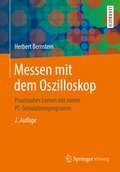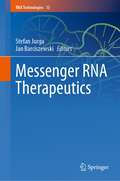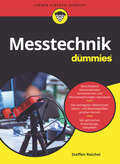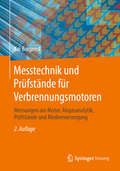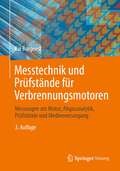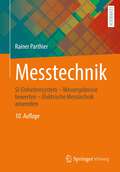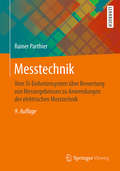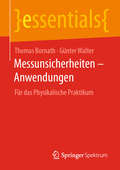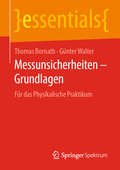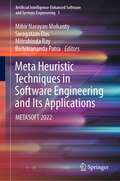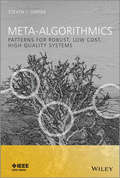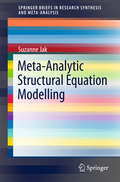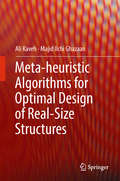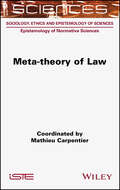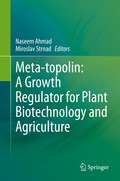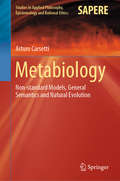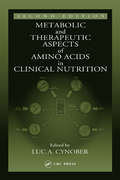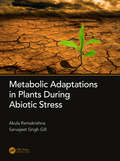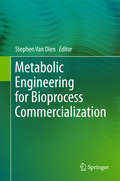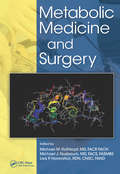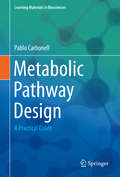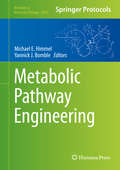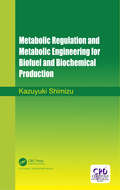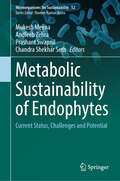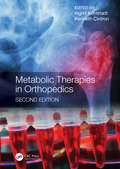- Table View
- List View
Messen mit dem Oszilloskop: Praxisnahes Lernen mit einem PC-Simulationsprogramm
by Herbert BernsteinDieses Buch ist für Studium, Labor und Berufspraxis konzipiert und gibt Anleitungen mit praxisorientierten Fakten. Es werden komplexe Zusammenhänge beim Arbeiten und Messen mit einem analogen Oszilloskop mit Bildröhre und beim Arbeiten und Messen mit einem digitalen Oszilloskop mit LCD-Bildschirm anhand vieler Versuche aus der Elektrotechnik und Elektronik erklärt. Zahlreiche Messversuche mit kostenlosem Simulator runden das Fachbuch ab.
Messenger RNA Therapeutics (RNA Technologies #13)
by Jan Barciszewski Stefan JurgaThis book focuses on the fundamentals and applications of messenger RNA (mRNA)-based therapeutics and discusses the strengths and key challenges of this emerging class of drugs. In the past 30 years, extensive research and technological development in many areas have contributed to the emergence of in vitro transcribed mRNA as a therapeutic that has now reached clinical testing. Formulations that protect the mRNA from nucleases and accelerate its cellular uptake, combined with improvements to the mRNA molecules themselves, have been critical advancements for mRNAs to become viable therapeutics. Though once regarded as a serious impediment, the transient nature of mRNA technology is now considered a major advantage in making mRNA therapies safe and, ultimately, a potential game changer in the field of medicine. This new book in the RNA Technologies series provides a state-of-the-art overview on the emerging field of mRNA therapeutics covering essential strategies for formulation, delivery, and application. It also reviews the promising role in cancer immunotherapy, respiratory diseases, and chronic HBV infection and discusses RNA vaccines in light of the current COVID-19 pandemic. mRNA-based approaches have great potential to revolutionize molecular biology, cell biology, biomedical research, and medicine. Thus, this handbook is an essential resource for researchers in academia and industry contributing to the development of this new area of therapeutics.
Messtechnik für Dummies (Für Dummies)
by Steffen ReichelDieses Buch bietet Ihnen eine verständliche Einführung in die Messtechnik, mitsamt den nötigen mathematischen und statistischen Grundlagen. Der Autor führt Sie dabei mit zahlreichen praxisnahen Beispielen durchs gesamte Thema. Der Fokus liegt auf der modernen Messtechnik, also beispielsweise dem Einsatz von digitalen Multimetern. Lernen Sie, die Geräte korrekt zu nutzen, Messabweichungen zu erkennen und zu vermeiden sowie nach den Messungen alles präzise zu berechnen. Von den verschiedenen Messmethoden über die Messung von Widerstand und Leistung bis zur Bestimmung der Impedanz ist alles dabei. Dank anschaulichen Abbildungen und Diagrammen steht dem Lernerfolg nichts mehr im Wege.
Messtechnik und Prüfstände für Verbrennungsmotoren: Messungen am Motor, Abgasanalytik, Prüfstände und Medienversorgung
by Kai BorgeestDieses Buch vermittelt sowohl Studenten, als auch Planern und Betreibern in Industrie und Wissenschaft das nötige umfangreiche Wissen, um Messungen an Motorenprüfständen durchführen zu können. Messtechnik und Prüfstände für Verbrennungsmotoren helfen, Kraftstoff einzusparen, Treibhausgase und Schadstoffe zu reduzieren, mit kleineren Motoren mehr Leistung abzugeben sowie Komponenten und Betriebsstoffe zu optimieren. Mit den Motoren und der Abgasgesetzgebung entwickelt sich auch die für die Entwicklung erforderliche mechanische, thermodynamische und Abgasmesstechnik weiter.
Messtechnik und Prüfstände für Verbrennungsmotoren: Messungen am Motor, Abgasanalytik, Prüfstände und Medienversorgung
by Kai BorgeestDieses Buch vermittelt sowohl Studenten, als auch Planern und Betreibern in Industrie und Wissenschaft das nötige umfangreiche Wissen, um Messungen an Motorenprüfständen durchführen zu können. Messtechnik und Prüfstände für Verbrennungsmotoren helfen, Kraftstoff einzusparen, Treibhausgase und Schadstoffe zu reduzieren, mit kleineren Motoren mehr Leistung abzugeben sowie Komponenten und Betriebsstoffe zu optimieren. Mit den Motoren und der Abgasgesetzgebung entwickelt sich auch die für die Entwicklung erforderliche mechanische, thermodynamische und Abgasmesstechnik weiter.
Messtechnik: SI-Einheitensystem – Messergebnisse bewerten – Elektrische Messtechnik anwenden (Viewegs Fachbücher Der Technik Ser.)
by Rainer ParthierDieses Lehr- und Übungsbuch erläutert anschaulich Prinzipien und moderne Verfahren der elektrischen Messtechnik. Es hilft direkt messtechnische Fragestellungen richtig einzuschätzen. Kontrollfragen und Übungsaufgaben ermöglichen eine selbstständige Lernkontrolle und damit ein erfolgreiches Selbststudium. Die vorliegende Auflage wurde überarbeitet und aktualisiert. Das Kapitel Automatisierte Messsysteme wurde an den aktuellen technischen Fortschritt angepasst.
Messtechnik: Vom SI-Einheitensystem über Bewertung von Messergebnissen zu Anwendungen der elektrischen Messtechnik (Studium Technik Ser.)
by Rainer ParthierDieses Lehr- und Übungsbuch erläutert anschaulich Prinzipien und moderne Verfahren der elektrischen Messtechnik. Es hilft direkt messtechnische Fragestellungen richtig einzuschätzen. Kontrollfragen und Übungsaufgaben ermöglichen eine selbstständige Lernkontrolle und damit ein erfolgreiches Selbststudium. Die 9. Auflage wurde gezielt um praxisrelevante Übungsaufgaben erweitert und unter anderem wurden die Grundzüge des neuen SI-Einheitensystems eingearbeitet.
Messunsicherheiten – Anwendungen: Für das Physikalische Praktikum (essentials)
by Thomas Bornath Günter WalterIn diesem Buch wird die Auswertung von Messdaten mit ihren Unsicherheiten für die Anwendung im Physikalischen Praktikum dargestellt. Für die wesentlichen Typen von Messaufgaben findet der Leser eine Zusammenstellung aller nötigen Formeln zur Bestimmung des Bestwertes und der kombinierten und erweiterten Messunsicherheit sowie praktische Hinweise für die Ermittlung von Unsicherheiten nach Typ B (nichtstatistische Methode). Zahlreiche durchgerechnete Beispiele geben konkrete Anleitungen und demonstrieren, wie die Ergebnisse ins Praktikumsprotokoll eingehen und wie sie diskutiert werden. Das vorliegende Kompendium ist sowohl für Studierende in einem Bachelor- oder Lehramtsstudiengang Physik als auch für Studierende in natur- und ingenieurwissenschaftlichen Studiengängen mit Nebenfach Physik geeignet.
Messunsicherheiten – Grundlagen: Für das Physikalische Praktikum (essentials)
by Thomas Bornath Günter WalterIn diesem Buch wird der Umgang mit Messdaten und ihren Unsicherheiten in knapper und anschaulicher Weise dargestellt. Im „Leitfaden zur Angabe der Unsicherheit beim Messen“ (ISO/IEC 98-3:2008) sind die Terminologie und die Methoden für die Behandlung von Messunsicherheiten international standardisiert. Auf dieser Grundlage werden dem Leser Kenntnisse über das Wesen von Messabweichungen, über Messunsicherheit und Wahrscheinlichkeitsverteilung, die Bestimmung der kombinierten und erweiterten Messunsicherheit und über Ausgleichsrechnung vermittelt.Das vorliegende Kompendium ist sowohl für Studierende in einem Bachelor- oder Lehramtsstudiengang Physik als auch für Studierende in natur- und ingenieurwissenschaftlichen Studiengängen mit Nebenfach Physik geeignet.
Meta Heuristic Techniques in Software Engineering and Its Applications: METASOFT 2022 (Artificial Intelligence-Enhanced Software and Systems Engineering #1)
by Swagatam Das Mihir Narayan Mohanty Mitrabinda Ray Bichitrananda PatraThis book discusses an integration of machine learning with metaheuristic techniques that provide more robust and efficient ways to address traditional optimization problems. Modern metaheuristic techniques, along with their main characteristics and recent applications in artificial intelligence, software engineering, data mining, planning and scheduling, logistics and supply chains, are discussed in this book and help global leaders in fast decision making by providing quality solutions to important problems in business, engineering, economics and science. Novel ways are also discovered to attack unsolved problems in software testing and machine learning. The discussion on foundations of optimization and algorithms leads beginners to apply current approaches to optimization problems. The discussed metaheuristic algorithms include genetic algorithms, simulated annealing, ant algorithms, bee algorithms and particle swarm optimization. New developments on metaheuristics attract researchers and practitioners to apply hybrid metaheuristics in real scenarios.
Meta-Algorithmics: Patterns for Robust, Low Cost, High Quality Systems (Wiley - IEEE)
by Steven J. SimskeThe confluence of cloud computing, parallelism and advanced machine intelligence approaches has created a world in which the optimum knowledge system will usually be architected from the combination of two or more knowledge-generating systems. There is a need, then, to provide a reusable, broadly-applicable set of design patterns to empower the intelligent system architect to take advantage of this opportunity. This book explains how to design and build intelligent systems that are optimized for changing system requirements (adaptability), optimized for changing system input (robustness), and optimized for one or more other important system parameters (e.g., accuracy, efficiency, cost). It provides an overview of traditional parallel processing which is shown to consist primarily of task and component parallelism; before introducing meta-algorithmic parallelism which is based on combining two or more algorithms, classification engines or other systems. Key features: Explains the entire roadmap for the design, testing, development, refinement, deployment and statistics-driven optimization of building systems for intelligence Offers an accessible yet thorough overview of machine intelligence, in addition to having a strong image processing focus Contains design patterns for parallelism, especially meta-algorithmic parallelism – simply conveyed, reusable and proven effective that can be readily included in the toolbox of experts in analytics, system architecture, big data, security and many other science and engineering disciplines Connects algorithms and analytics to parallelism, thereby illustrating a new way of designing intelligent systems compatible with the tremendous changes in the computing world over the past decade Discusses application of the approaches to a wide number of fields; primarily, document understanding, image understanding, biometrics and security printing Companion website contains sample code and data sets
Meta-Analytic Structural Equation Modelling
by Suzanne JakThis book explains how to employ MASEM, the combination of meta-analysis (MA) and structural equation modelling (SEM). It shows how by using MASEM, a single model can be tested to explain the relationships between a set of variables in several studies. This book gives an introduction to MASEM, with a focus on the state of the art approach: the two stage approach of Cheung and Cheung & Chan. Both, the fixed and the random approach to MASEM are illustrated with two applications to real data. All steps that have to be taken to perform the analyses are discussed extensively. All data and syntax files are available online, so that readers can imitate all analyses. By using SEM for meta-analysis, this book shows how to benefit from all available information from all available studies, even if few or none of the studies report about all relationships that feature in the full model of interest.
Meta-heuristic Algorithms for Optimal Design of Real-Size Structures
by Ali Kaveh Majid Ilchi GhazaanThe contributions in this book discuss large-scale problems like the optimal design of domes, antennas, transmission line towers, barrel vaults and steel frames with different types of limitations such as strength, buckling, displacement and natural frequencies. The authors use a set of definite algorithms for the optimization of all types of structures. They also add a new enhanced version of VPS and information about configuration processes to all chapters. Domes are of special interest to engineers as they enclose a maximum amount of space with a minimum surface and have proven to be very economical in terms of consumption of constructional materials. Antennas and transmission line towers are the one of the most popular structure since these steel lattice towers are inexpensive, strong, light and wind resistant. Architects and engineers choose barrel vaults as viable and often highly suitable forms for covering not only low-cost industrial buildings, warehouses, large-span hangars, indoor sports stadiums, but also large cultural and leisure centers. Steel buildings are preferred in residential as well as commercial buildings due to their high strength and ductility particularly in regions which are prone to earthquakes.
Meta-theory of Law
by Mathieu CarpentierThis book is devoted to the theory of legal theory, also referred to as the "meta-theory of law".The aim of this emerging discipline is to determine the objectives, aims and methods of legal theory, and to establish the conditions of possibility as well as the validity criteria for theoretical discourse on law. The contributions in this book provide an overview of these aspects through different perspectives and approaches.The very purpose of legal theory has been disputed and the subject area is currently subject to increasing cross-fertilization between different, and sometimes diverging, traditions. Meta-theory of Law assesses these emerging trends by questioning two basic objects of legal theory, the "nature" and the "science" of law.
Meta-topolin: A Growth Regulator for Plant Biotechnology and Agriculture
by Naseem Ahmad Miroslav StrnadPlant tissue culture (PTC) technology has gained unassailable success for its various commercial and research applications in plant sciences. Plant growth regulators (PGRs) are an essential part of any plant tissue culture intervention for propagation or modification of plants. A wide range of PGRs are available, including aromatic compounds that show cytokinin activities, promote cell division and micro-propagation, viz. kinetin, N6-benzyladenine and topolins. Topolins are naturally occurring aromatic compounds that have gained popularity as an effective alternative for other frequently used cytokinins in in vitro culture of plants. Among them, meta-topolin [6-(3-hydroxybenzlyamino) purine] is the most popular and its use in plant tissue culture has amplified swiftly. During the last few decades, there have been numerous reports highlighting the effectiveness of meta-topolin in micropropagation and alleviation of various physiological disorders, rooting and acclimatization of tissue culture raised plants.
Metabiology: Non-standard Models, General Semantics and Natural Evolution (Studies in Applied Philosophy, Epistemology and Rational Ethics #50)
by Arturo CarsettiIn the context of life sciences, we are constantly confronted with information that possesses precise semantic values and appears essentially immersed in a specific evolutionary trend. In such a framework, Nature appears, in Monod’s words, as a tinkerer characterized by the presence of precise principles of self-organization. However, while Monod was obliged to incorporate his brilliant intuitions into the framework of first-order cybernetics and a theory of information with an exclusively syntactic character such as that defined by Shannon, research advances in recent decades have led not only to the definition of a second-order cybernetics but also to an exploration of the boundaries of semantic information. As H. Atlan states, on a biological level "the function self-organizes together with its meaning". Hence the need to refer to a conceptual theory of complexity and to a theory of self-organization characterized in an intentional sense. There is also a need to introduce, at the genetic level, a distinction between coder and ruler as well as the opportunity to define a real software space for natural evolution. The recourse to non-standard model theory, the opening to a new general semantics, and the innovative definition of the relationship between coder and ruler can be considered, today, among the most powerful theoretical tools at our disposal in order to correctly define the contours of that new conceptual revolution increasingly referred to as metabiology. This book focuses on identifying and investigating the role played by these particular theoretical tools in the development of this new scientific paradigm. Nature "speaks" by means of mathematical forms: we can observe these forms, but they are, at the same time, inside us as they populate our organs of cognition. In this context, the volume highlights how metabiology appears primarily to refer to the growth itself of our instruments of participatory knowledge of the world.
Metabolic & Therapeutic Aspects of Amino Acids in Clinical Nutrition
by Luc A. CynoberThe first edition of this innovative book brought a new perspective to the metabolic and therapeutic aspects of amino acids in clinical nutrition. Since its publication, a number of very important advances have been made in the field and interesting new findings have emerged. Until now, no reference has fully explored the promising new developments
Metabolic Adaptations in Plants During Abiotic Stress
by Sarvajeet Singh Gill Akula RamakrishnaKey features: Serves as a cutting-edge resource for researchers and students who are studying plant abiotic stress tolerance and crop improvement through metabolic adaptations Presents the latest trends and developments in the field of metabolic engineering and abiotic stress tolerance Addresses the adaptation of plants to climatic changes Gives special attention to emerging topics such as the role of secondary metabolites, small RNA mediated regulation and signaling molecule responses to stresses Provides extensive references that serve as entry points for further research Metabolic Adaptations in Plants during Abiotic Stress covers a topic of past, present and future interest for both scientists and policy makers as the global challenge of climate change is addressed. Understanding the mechanisms of plant adaptation to environmental stresses can provide the necessary tools needed to take action to protect them, and hence ourselves. This book brings together recent findings about metabolic adaptations during abiotic stress and in diverse areas of plant adaptation. It covers not only the published results, but also introduces new concepts and findings to offer original views on the perspectives and challenges in this field.
Metabolic Engineering for Bioprocess Commercialization
by Stephen Van DienThis volume reviews the current metabolic engineering tools and technologies from a practical point of view, and guides researchers as they overcome challenges at various stages of organism and bioprocess development. Microbes have been engineered to produce a variety of industrial products such as fuels, basic chemicals, fine chemicals, nutritional supplements, and pharmaceutical intermediates, and new tools such as gene synthesis, advanced cloning techniques, 'omics' analysis, and mathematical modeling have greatly accelerated the pace of innovation in the field. Written by leading experts in the field from both academia and industry, key topics include synthetic biology, pathway engineering, metabolic flux manipulation, adaptive evolution, and fermentation process scale-up. It is suitable for non-specialists, and is a valuable resource for anyone embarking on the exciting path to harnessing the metabolic potential of microorganisms.
Metabolic Medicine and Surgery
by Michael M. Rothkopf Michael J. Nusbaum Lisa P HaverstickThe first comprehensive overview of an emerging field, Metabolic Medicine and Surgery introduces a new paradigm in patient management that crosses existing subspecialty boundaries. This approach is necessitated by the challenges of treating patients with obesity, metabolic syndrome, cardiovascular disease and prediabetes, as well as those with mald
Metabolic Pathway Design: A Practical Guide (Learning Materials in Biosciences)
by Pablo CarbonellThis textbook presents solid tools for in silico engineering biology, offering students a step-by-step guide to mastering the smart design of metabolic pathways. The first part explains the Design-Build-Test-Learn-cycle engineering approach to biology, discussing the basic tools to model biological and chemistry-based systems. Using these basic tools, the second part focuses on various computational protocols for metabolic pathway design, from enzyme selection to pathway discovery and enumeration. In the context of industrial biotechnology, the final part helps readers understand the challenges of scaling up and optimisation. By working with the free programming language Scientific Python, this book provides easily accessible tools for studying and learning the principles of modern in silico metabolic pathway design. Intended for advanced undergraduates and master’s students in biotechnology, biomedical engineering, bioinformatics and systems biology students, the introductory sections make it also useful for beginners wanting to learn the basics of scientific coding and find real-world, hands-on examples.
Metabolic Pathway Engineering (Methods in Molecular Biology #2096)
by Michael E. Himmel Yannick J. BombleThis book illustrates experimental and computational methodologies used to achieve cost effective biological processes for the production of fuels and biochemicals through multiple approaches to increasing yield, titers, and productivity in a robust host. The volume includes the most recent and cutting-edge aspects of pathway engineering, flux analysis, and metabolic enzyme engineering. Each chapter highlights the complexity and challenges of the problem as well as the methods used to solve this problem or changes needed in current methods. As a part of the highly successful Methods in Molecular Biology series, chapters include the kind of detailed implementation advice that gives researchers a much needed boost. Authoritative and practical, Metabolic Pathway Engineering benefits not only scientists working on more fundamental aspects of this endeavor but also those in the biochemical industry working on strain engineering for robust industrial processes.
Metabolic Regulation and Metabolic Engineering for Biofuel and Biochemical Production
by Kazuyuki ShimizuThe global warming problem is becoming critical year by year, causing climate disaster all over the world, where it has been believed that the CO2 gas emitted from the factories and the burning of fossil fuels may be one of the reasons of global warming. Moreover, the global stock of fossil fuels is limited, and may run out soon within several tens of years. Although wind, geo-thermal, and tide energies have been considered as clean energy sources, those depend on the land or sea locations and subject to the climate change. Biofuel and biochemical production from renewable bio-resources has thus been paid recent attention from environmental protection and energy production points of view, where the current chemical and energy producing plants can be also utilized with slight modification. The so-called 1st generation biofuels have been produced from corn starch and sugarcane in particular in USA and Brazil. However, this causes the problem of the so-called "food and energy issues" as the production scale increases. The 2nd generation biofuel production from lingo-cellulosic biomass or wastes has thus been paid recent attention. However, it requires energy intensive pretreatment for the degradation of lingo-cellulosic biomass, and the fermentation is slow due to low growth rate, and thus the productivity of biofuels and bio-chemicals is low. The 3rd generation biofuel production from photosynthetic organisms such as cyanobacteria and algae has been also paid attention, because such organisms can grow with only sun light and CO2 in the air, but the cell growth rate and thus the productivity of the fuels is significantly low. The main part or core of such production processes is the fermentation by micro-organisms. In particular, it is critical to properly understand the cell metabolism followed by the efficient metabolic engineering. The book gives comprehensive explanation of the cell metabolism and the metabolic regulation mechanisms of a variety of micro-organisms. Then the efficient metabolic engineering approaches are explained to properly design the microbial cell factories for the efficient cell growth and biofuel and biochemical production.
Metabolic Sustainability of Endophytes: Current Status, Challenges and Potential (Microorganisms for Sustainability #52)
by Chandra Shekhar Seth Mukesh Meena Andleeb Zehra Prashant SwapnilThis book describes the diversity and functional roles of fungal endophytes. It explains their beneficial impacts along with the practical applications in crop production. The endophytes are an important possibility for research on future medications and biopesticides in view of the production of secondary metabolites. In the context of agriculture, the book chapters delve into the biostimulant properties of endophytic fungi, offering sustainable solutions for crop production. This extends to their relationships with medicinal plants, paving the way for potential breakthroughs in medicine and agriculture alike. The book encompasses the adaptability and potential of endophytic fungi, emphasizing their future role as biostimulants for the viable bioprospecting of high-value secondary metabolites. Molecular mechanisms governing future host-endophyte interactions is discussed to provide a deeper understanding of signaling pathways. This book is an important asset for future students, researchers in plant science, and professionals across diverse industries, fostering a nuanced comprehension of fungal endophytes and their multifaceted roles in the pursuit of future metabolic sustainability.
Metabolic Therapies in Orthopedics, Second Edition
by Ingrid Kohlstadt Kenneth CintronThe first medical reference textbook to compile an unprecedented synthesis of evidence for regenerative orthopedics by key opinion leaders Thirty-five authors address your clinical questions What emerging technologies are right for my clinical practice? How can I strengthen my patients before their orthopedic surgery? Practically speaking, how can I leverage the latest metabolic therapies to safeguard my patients from toxins, medications, food and chronic diseases known to adversely affect the musculoskeletal system? "Ask the Author" feature Would you like to discuss a patient with a particular author? Now you can do so at www.betterorthopedics.com. First to be second Did you notice this book is the first book in regenerative orthopedics to publish a second edition? This diverse author team leads the growing field of regenerative orthopedics and offers the broadest and in-depth approach to leveraging metabolic therapies. This book comprises the professional opinion of its authors. It does not claim to represent guidelines, recommendations, or the current standard of medical care.
